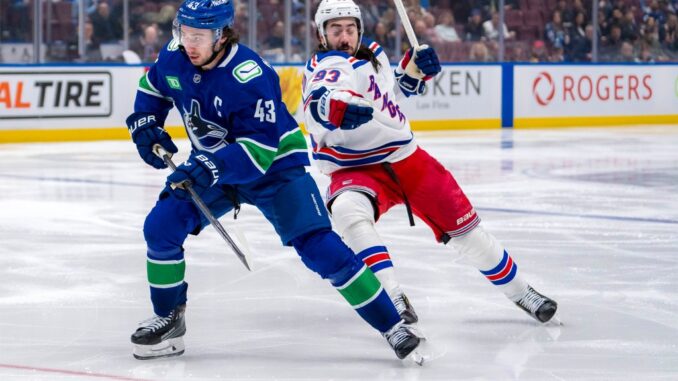
Growing up in New England, Kelly Dyer was a product of the Bobby Orr explosion. On the streets outside her house, neighborhood kids emulated their hero. Dyer pieced together a set of goalie pads from garbage she found in dumpsters, her sewing kit and shoe glue. Soon, Massachusetts began building more arenas and it was on one of these rinks that Dyer first stepped on the ice.
“I started as a figure skater because at the time that was the only way girls could get on the ice,” Dyer recalls. “But my brother David, who’s two years older, was a hockey player so I would get off the figure skating rink and run over to the hockey rink to watch. I always wanted to play hockey and begged for two years until my father found Assabet in Concord, the next town over. My first day of skating with Assabet was in my brother’s equipment with figure skates.”
It didn’t take long for Dyer to skyrocket up the ranks at Assabet, aided by a high school program that included future NHLers Bob Sweeney and Jeff Norton. Her goaltending partner at the school was future Hockey Hall of Famer Tom Barrasso. She went on to play four years of NCAA hockey at Northeastern, graduating just in time to try out for the national team ahead of the inaugural 1990 world championships. As tryouts took place at Northeastern, Dyer didn’t even need to move the equipment from her stall. She just changed the color of her jersey when she was named to Team USA.
Suiting up for Team USA in the gold-medal game changed her life forever. “It was one of the greatest events of my life, probably second only to the birth of my child,” Dyer says. “It was amazing to see and feel the energy in the arena for a women’s hockey game.”
Coming home from the first world championships in Ottawa, Dyer saw a huge gap in the women’s game, one that often left women’s bodies unprotected. Even the top players in the world were forced to use equipment designed for men. There was no other alternative.
Dyer also recognized that women were an afterthought in the hockey equipment industry. Now she saw an opportunity. “I would see players – Cammi Granato is a perfect example – I think she played at 5ft 7in and let’s say 130 lbs. So she’d have to wear a men’s medium pant for the pad to come down to her shin guards. But then she’d have to take the waist and cinch it in tight because she was slender. So now her kidney pads are in front of her belly,” she explains. “Bending forward to tie their skates, players had to re-open their pants to let the hard plastic kidney pads flare out and then do them back up. So players were carrying this extra bulk where they needed dynamic movement and had no protection on their kidneys. I thought, this is ridiculous.
Dyer had one mission in mind: to find a company willing to manufacture sticks and protective equipment specifically built for women. “Coming from USA Hockey, we just had hockey pants that the men wore. They were heavy and weren’t good for performance or for protection. So that became my motto, performance and protection. Protection because our equipment kept the padding in place where players needed it, and performance because it fit and it didn’t shift all over.
“I had a good amount of attention coming back from the 1990 world championships. I just came home and I was so pumped and so full of energy and visions in a thousand directions of where women’s sports could go,” she explains. “I just picked up the phone and called every single person I could think of and I called every single hockey manufacturer. I had a long conversation with Bauer and they were seemingly supportive but then they just couldn’t commit the time or the manufacturing to it.”
One company, however, said yes. And it changed the game forever.
“I ended up with Louisville Hockey because they were Canadian so there was less time delay in trying new equipment as we were tweaking it,” she explains. “They were small enough to be flexible, and they were committed to me, so I switched to wearing their product in 1992. I really became part of the family as soon as I started work.” She would spend the next 17 years working with the company.
In the back of Team USA’s bus, Kelly Dyer sketched out ideas, using her teammates as models: Lisa Brown-Miller for size small, Cammi Granato for size medium, and Kelly O’Leary for large. “Everybody was constantly pulling their pants up and you couldn’t keep them up,” Dyer explains. “The same with shoulder pads. We had kids wearing these massive shoulder pads, so I really saw a need. With gloves, women don’t have the depth in the fingers, so you have all this material taking away from maximizing your strength. Just thinning out the gussets on the fingers and then narrowing them meant that when you went to make a grip you were using the full strength of your hand. Instead of having your hand spread out, you were actually maximizing the transference of your energy through the stick. Before, a lot of girls would cut their palms out, but then they’d have all this extra material dangling off the back of their hands.”
It was a significant shift for women who had been filing the picks off figure skates and wearing their brothers’ equipment for decades. “The sticks – first we did wood, but then we went with composites. Louisville bought Fontaine so we had the wood blades with the melt-in composite shaft. We made women’s sticks with a smaller radius, we made gloves, we made shoulder pads with breast protection, and we made pants that were shorter on the torso and longer in the legs.”
Be the first to comment